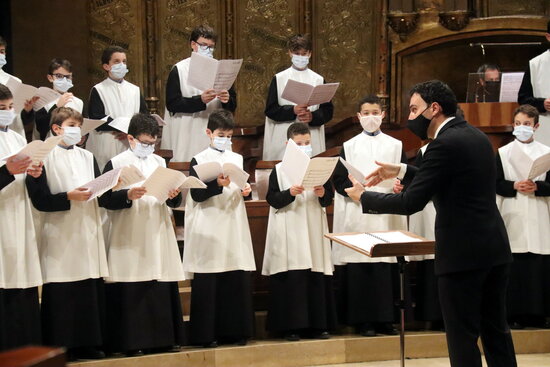Montserrat: a mountain, a religious symbol, and a world-class choir
With its rocky peaks and an ancient monastery, it is a staple of Catalonia — and a tourist hotspot

If one had to explain what makes Montserrat unique, the greatest challenge would be settling on a single reason.
For beginners, Montserrat is a multi-peaked mountain range, with summits as high as 1,236 meters above sea level, resembling a lone yet large rocky citadel emerging from the plains of central Catalonia.
Yet Montserrat is also home to a 1,000-year-old Benedictine monastery, which has played a pivotal role throughout Catalonia’s history, and houses a world-famous boys’ choir and the iconic carved sculpture of a black Madonna known as ‘La Moreneta’.
And then, of course, there’s also the monastery’s library encompassing 300,000 books and a museum featuring 1,300 artworks, including paintings by artists such as Caravaggio, Picasso, Dalí, or Monet.
Over the last decades, with the boom of the tourism industry in Catalonia, and especially Barcelona, Montserrat has also become the most popular attraction outside of the Catalan capital, with 2.7 million people visiting the complex in 2019.
How to get there
Montserrat’s proximity to Barcelona can help explain its overwhelming popularity. The monastery is a mere hour drive from the city center, while public transportation is also a quick and affordable way to get to the abbey.
A favorite way of getting there from the foot of the mountain to the monastery is the rack train, which takes visitors on a 15-minute ride through Montserrat’s rocky formations.
The train was first inaugurated in 1892. During the Spanish Civil War in the 1930s, it was used to carry injured soldiers to the military hospital located on the mountain. It stopped running in the 50s following a fatal accident and the growth in other means of transport aided by road access or the cable car. It reopened in the 2000s as Montserrat was becoming a tourist hotspot.
The challenges facing the boys’ choir
One of Montserrat’s crown jewels is the Escolania boys’ choir, dating back 700 years, and which has evolved into a top-notch music school for kids aged 9 to 14, recognized by the BBC as one of the world’s top ten choirs.
Speaking to Catalan News, 12-year-olds Pol Caro and Albert Folch explain that as students at the Escolania they spend the week at Montserrat, which has a boarding school, and go home for the weekend to spend time with their families.
Their main tasks consist of singing at the daily mass, with their catalogue including hundreds of music compositions spanning centuries. The most famous of all, often referenced in popular culture, is the ‘Virolai’, dedicated to the black Madonna.
In the morning, boys take regular courses, such as math, science, or English, and after lunch they focus on the musical training, with each student learning to play piano and a second instrument.
"There are lots of good friends, lots of good teachers, and a lot of music," said Caro. Folch stressed that his favorite things were "all the concerts" and going on tour abroad. The choir has visited Norway, Russia, or Germany in recent years.
Efrem de Montellà, a monk and the Escolania director, said that the pandemic has posed an existential threat to the institution, with new admissions plummeting over the last year.
However, the Escolania resists the idea of admitting girls, citing the importance of a historic tradition and alleging that boys could be shy singing next to girls. "Changes take time and don't happen immediately," he said. "For now, our approach has been to maintain the ancient tradition."
Central to achieving musical excellence are resources. There are 30 teachers and under 50 students. Tuition is a few hundred euros a month, but that is a tiny fraction of the Escolania’s real cost, which receives financial contributions from public institutions and private sponsors.
The agreement between the Escolania and the Catalan government’s Department of Education, which media outlets say has translated into millions of euros in public subsidies, has attracted criticism from the largest teachers’ union, USTEC, which called it an "aberration," saying that twice as much public money goes to each Escolania student than to public school students.
The black Madonna
Another key element of Montserrat is ‘La Moreneta,’ the celebrated black Madonna whose origins remain the subject of myths.
Legend has it that two young shepherds found the figure at the end of the ninth century. They saw a light shining on the mountain and found her inside a cave. The bishop of Manresa, a nearby town, wanted to bring the madonna there, but it was too heavy. This was taken as a sign that she had to be left where she was found and a monastery was eventually built around her.
The statue currently on display, carved out of wood and allegedly blackened by the smoke of candles, is believed to date back to the XII century.
In 1881, pope Leon XIII officially proclaimed the Mare de Déu de Montserrat (Montserrat’s Virgin Mary) as the patron saint of Catalonia, with the festivity celebrated every year on April 27.